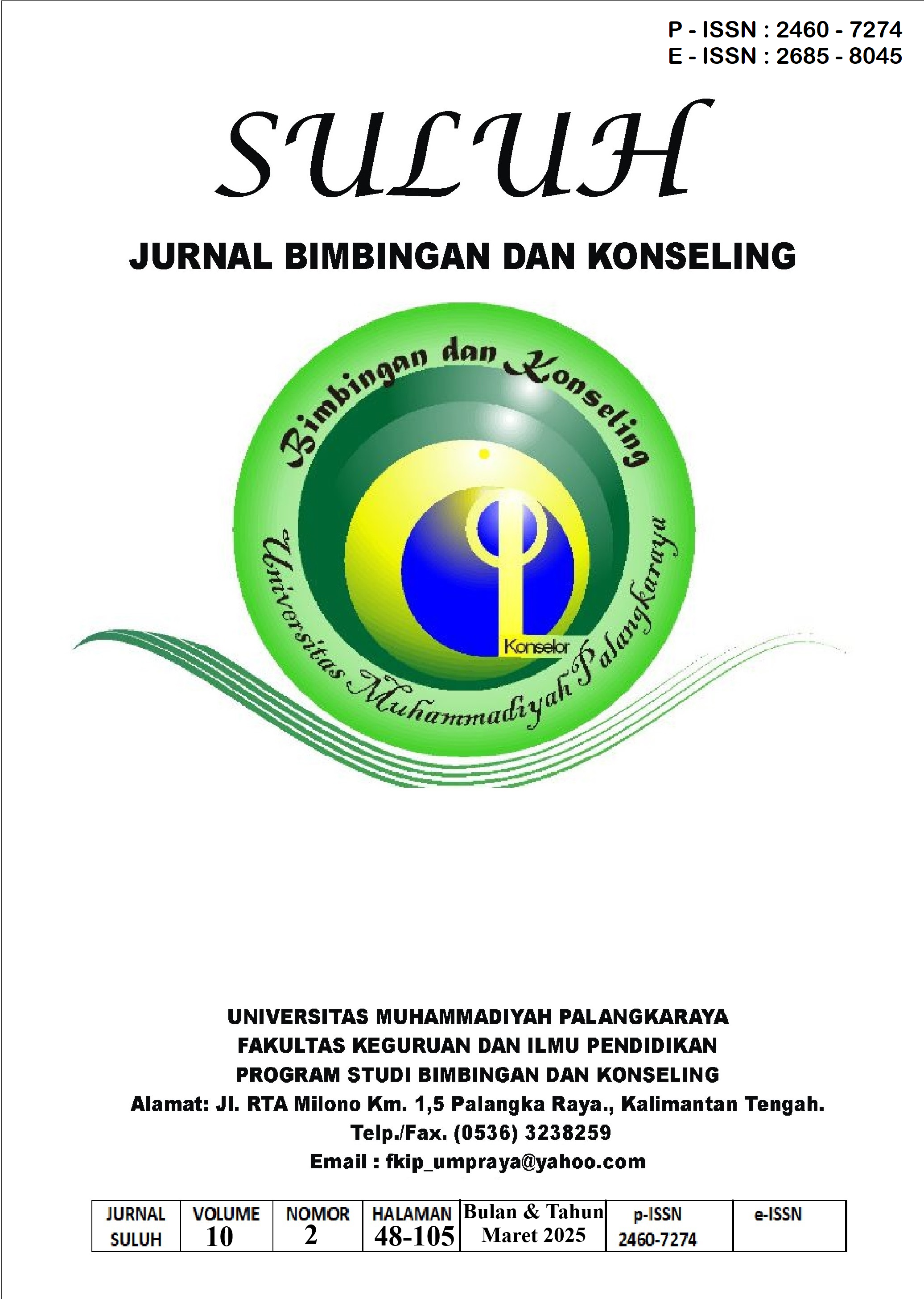The Influence of Parental Attachment and Autonomy on Juvenile Delinquency Among Vocational High School Students at Karsa Mulya in Palangkaraya
Main Article Content
Abstract
This study reveals the phenomenon of juvenile delinquency among students of SMK Karsa Mulya by understanding the influence of parental attachment and independence on juvenile delinquency in SMK Karsa Mulya Palangkaraya students. This study focuses on the impact of parental attachment (father, mother) and independence on juvenile delinquency. The research design used is a multiple linear correlational research design with a sample of 114 from a population of 270 class X students. Sampling used probability sampling with a random sampling technique. Meanwhile, the calculation of data results using the SPSS 2018 application from 4 questionnaire instruments Inventory of Parent and Peer Attachment (IPPA), Autonomy Scale, and Self Report Delinquency Scale, with the results that there is no relationship between parental attachment and independence on juvenile delinquency, negatively correlated (-) namely the significance value of IPPA MOTHER p = 0.494> 0.05, not significant, IPPAFATHER: p = 0.889> 0.05 is not significant, while the autonomy value p = 0.172> 0.05 is not significant. However, there is a relationship if the three variables are combined, with a value of p = 0.006 <0.05, meaning that the higher the attachment of mother/father and independence, the lower the level of juvenile delinquency.
Downloads
Article Details

This work is licensed under a Creative Commons Attribution-ShareAlike 4.0 International License.
All rights reserved. This publication may be reproduced, stored in a retrieval system, or transmitted in any form or by any means, electronic, mechanical, photocopying, recording.
References
Afrita, F., & Yusri, F. (2022). Faktor-Faktor Yang Mempengaruhi Kenakalan Remaja. Educativo: Jurnal Pendidikan, 2(1), 14–26. https://doi.org/10.56248/educativo.v2i1.101
Allen, J. P., Marsh, P., McFarland, C., McElhaney, K. B., Land, D. J., Jodl, K. M., & Peck, S. (2002a). Attachment and autonomy as predictors of the development of social skills and delinquency during midadolescence. Journal of Consulting and Clinical Psychology, 70(1), 56–66. https://doi.org/10.1037/0022-006X.70.1.56
Allen, J. P., Marsh, P., McFarland, C., McElhaney, K. B., Land, D. J., Jodl, K. M., & Peck, S. (2002b). Attachment and autonomy as predictors of the development of social skills and delinquency during midadolescence. Journal of Consulting and Clinical Psychology, 70(1), 56–66. https://doi.org/10.1037/0022-006X.70.1.56
Danisworo, D. L., & Wangid, M. N. (2022a). THE INFLUENCE OF FAMILY HARMONY AND EMOTIONAL REGULATION ABILITY ON JUVENILE DELINQUENCY. European Journal of Education Studies, 9(6). https://doi.org/10.46827/ejes.v9i6.4315
Danisworo, D. L., & Wangid, M. N. (2022b). The Influence Of Family Harmony And Emotional Regulation Ability On Juvenile Delinquency. European Journal of Education Studies, 9(6). https://doi.org/10.46827/ejes.v9i6.4315
DKK, P. (2022, February). ANALISIS DATA MULTIVARIAT. Omera Pustaka.
Fitriani, W., & Hastuti, D. (2016). Pengaruh Kelekatan Remaja dengan Ibu, Ayah dan Teman Sebaya terhadap Kenakalan Remaja di Lembaga Pembinaan Khusus Anak (LPKA) Kelas II Bandung. Jurnal Ilmu Keluarga Dan Konsumen, 9(3), 206–217. https://doi.org/10.24156/jikk.2016.9.3.206
Fleming, M. (n.d.). Adolescent Autonomy: Desire, Achievement and Disobeying Parents between Early and Late Adolescence.
Fleming, M. (2005). Adolescent Autonomy: Desire, Achievement and Disobeying Parents between Early and Late Adolescence. Ustralian Journal of Education and Developmental Psychology Vol. 5, 2005, Pp 1- 16, 5, 1–16.
Hafni, S. (2021, Mei). E-Book Metodologi Penelitian Syafrida.pdf. PENERBIT KBM INDONESIA.
Hoeve, E.van, H.van, M., Claudia,Peter. (2012, January 21). A Meta-analysis of Attachment to Parents and Delinquency. J Abnorm Child Psychol.
Ishfaq, N., & Kamal, A. (2019). Empirical Evidence of Multi-Facets of Delinquency in Pakistan: Revised Self-Reported Delinquency Scale. Pakistan Journal of Psychological Research, 34(Spring 2019), 115–137. https://doi.org/10.33824/PJPR.2019.34.1.7
Jia Choon, L., Hasbullah, M., Ahmad, S., & Shin Ling, W. (2013). Parental Attachment, Peer Attachment, and Delinquency among Adolescents in Selangor, Malaysia. Asian Social Science, 9(15), p214. https://doi.org/10.5539/ass.v9n15p214
Kurniawan, H., Okfrima, R., & Putry, A. (2022). Kelekatan Orangtua dengan Kemandirian Remaja Pada Siswa MTsS. Psyche 165 Journal, 37–42. https://doi.org/10.35134/jpsy165.v15i1.142
Luke, F. K. (2024). Influence of Attachment Styles on Delinquency among Adolescents in Church Managed Reintegration Centers in Lang'ata Sub-County, Nairobi County, Kenya. International Journal of Research and Innovation in Social Science, VIII(VIII), 3818–3825. https://doi.org/10.47772/IJRISS.2024.8080284
Malicha, S. (2021). HUBUNGAN KELEKATAN (ATTACHMENT) ORANG TUA DENGAN KEMANDIRIAN REMAJA MTs. REMAJA ROHMATUL UMMAH KABUPATEN MOJOKERTO. UIN Maulana Malik Ibrahim.
Nabila, F. (2020). PENGARUH ATTACHMENT DENGAN ORANG TUA DAN SELF-CONTROL TERHADAP KECENDERUNGAN KENAKALAN REMAJA DI SMK MUHAMMADIYAH 2 MALANG. Psikologi UIN Maulana Malik Ibrahim Malang.
Qudsiyah, U. (2018, March 23). PENGARUH INTERNAL LOCUS OF CONTROL, PARENTAL DAN FRIEND ATTACHMENT TERHADAP KEMATANGAN KARIR MELALUI SELF EFFICACY SEBAGAI MEDIATOR. UNIVERSITAS NEGERI SEMARANG 2018.
Rulmuzu, F. (2021). KENAKALAN REMAJA DAN PENANGANANNYA. 5(1).
Supriandi, A. (2024, July 14). Fenomena Remaja Mabuk Kecubung di Kalteng,. 1.
Thahir, A. (2018). Psikologi Perkembangan. http://repository.radenintan.ac.id/11010/1/PSIKOLOGI%20PERKEMBANGAN.pdf
William E. Thompson, Jack E. Bynum, William E. Thompson, Jack E. Bynum, & RThomson. (2016). Juvenile Delinquency: A Sociological Approach. Rowman and Littlefield.
Yusuf, M. (2017). Metode Penelitian Kuantitatif, Kualitatif & Penelitian Gabungan (Pertama, Vol. 4). Kencan.

